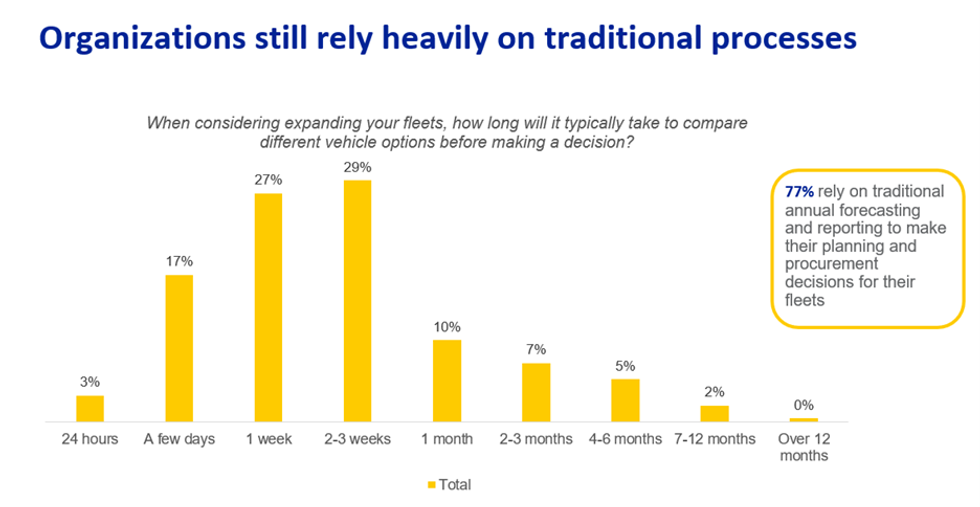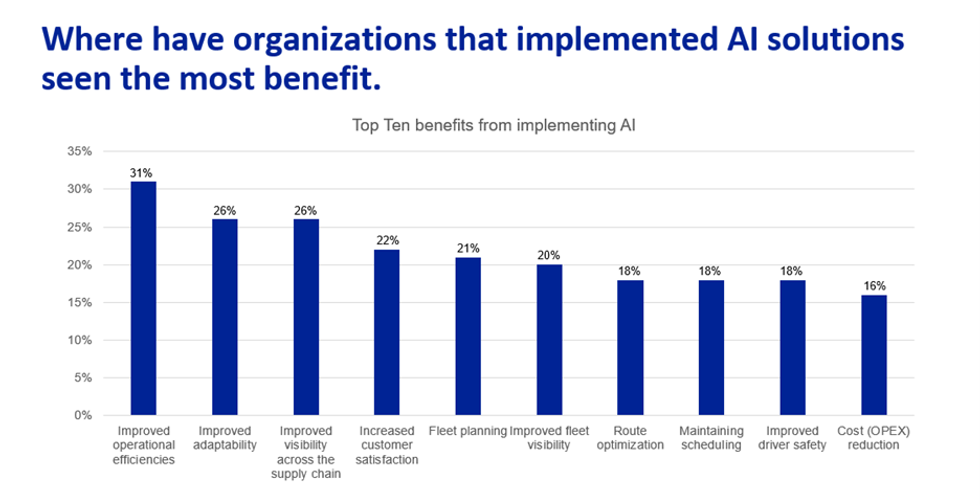Five Ways AI Can Improve Fleet Operations
Data, analytics and artificial intelligence are becoming essential tools in fleet management, and fleet leaders are leveraging technology to enhance operations and boost efficiency.
In Penske’s 2025 Transportation Leaders Survey: A Road to AI Adoption, which surveyed more than 250 transportation and logistics leaders, 97% of respondents agreed that benchmarking using real-time data and insights to monitor fleet and supply chain performance is becoming vital to navigating and thriving amidst economic volatility and sudden market shifts.
Additionally, 93% agreed that AI will improve resiliency and agility and better position organizations for future growth. Notably, 70% have already adopted at least some AI solutions, up from 53% in 2024.
The Role of AI and Machine Learning in Fleet Management
One of the reasons AI and advanced machine learning algorithms are so beneficial in transportation and logistics applications is that they excel at processing massive amounts of data in real time. Mining the data uncovers patterns and insights that human analysts might miss, leading to faster, smarter decision-making.
Penske, for example, receives more than 3,500 messages per second from a vehicle, totaling over 300 million messages daily across the fleet. “In fleet management, AI can take all of that data — those 3,500 messages per second — along with all of the variables and turn it into information that businesses can use to get detailed insights and make decisions,” said Tim Haynes, vice president of digital and customer data for Penske Transportation Solutions.
Survey respondents reported that AI has improved fleet planning (36%), route optimization (35%), operational efficiencies (34%) and driver safety (32%). Additionally, 40% of those adopting AI reported that it has delivered improvements of at least 50% in fuel savings, operational expenditures and distance traveled via route optimization.
Specific AI Use Cases
AI is driving meaningful improvements across several areas of fleet management, including:
Vehicle Performance: Vehicle performance monitoring enables fleet managers to delve into detailed, real-world performance data across their entire operation, right down to individual assets. With AI, they can track cost per mile at granular levels, identify underperforming vehicles or regions, and optimize replacement strategies to avoid holding on to assets for too long or retiring them prematurely. The data can also help fleets determine the optimal vehicle specifications for their operating conditions.
Rate Setting: Sifting through data using AI can help fleets identify the cost per mile for the fleet as a whole and at the individual asset level or operating area, which is critical for setting rates. By analyzing real-time and historical cost data, fleets can account for variables such as fuel prices, maintenance expenses and regional differences, enabling them to respond quickly to market fluctuations.
Fuel Efficiency: AI can uncover subtle trends in fuel consumption by analyzing driver habits, vehicle conditions and hub-level patterns. Having more information helps fleets detect inefficiencies, such as aggressive driving, maintenance issues or mismatched vehicle specifications, and quickly address them. Because different factors can influence fuel economy at different times, AI models continuously adapt to provide the most relevant, real-time feedback for maximizing savings.
Vehicle Utilization: Enhancing vehicle utilization improves fleet productivity and profitability. It helps fleets minimize idle time, optimize routes and balance workloads more effectively. Utilization can extend beyond the number of miles a vehicle travels to examine how long it’s running and whether it’s being used efficiently, which can help minimize unnecessary wear and tear, reduce empty miles and maximize revenue per trip.
Benchmarking: Rather than relying on static industry averages, fleets can utilize AI to measure their performance against their historical data and similar operations. AI automates reporting and provides real-time comparisons that reveal actionable opportunities for improvement, allowing fleet managers to make faster, more informed decisions. It can also automate the generation of reports on various fleet metrics, saving time and providing more accurate and timely information for decision-making.
Maintenance: By analyzing real-time fault codes and historical repair patterns, AI can predict equipment failures before they occur and recommend proactive maintenance. Penske’s combination of AI and decades of maintenance experience enables maintenance teams to not only indicate when a failure might happen but also identify the cause and determine whether it requires immediate attention or can wait for scheduled service. Taking a proactive approach reduces downtime, cuts maintenance costs and helps extend the life of fleet assets.
Catalyst AI Releases New Features for Smarter Fleet Decisions
Penske’s Catalyst AI™ is reshaping commercial fleet management by processing 100 billion data points and powering more than 300 real-time models to support intelligent decision-making from the individual vehicle to the entire fleet hub.
Penske recently released new features within Catalyst AI:
Fantasy Fleet: A new comparison set made up of top-performing vehicles most similar to each vehicle in the user’s fleet — helping them find gaps and elevate performance
Vehicle-Level Comparison: Users can compare individual vehicles to pinpoint performance differences, helping identify where targeted adjustments can drive better results
Hub-Level Comparison: Users can assess operations by location and uncover opportunities for improved efficiency at specific locations at the local level
Impacting Metrics: Users can focus on specific metrics that matter most to their business, including fuel efficiency, maintenance costs, utilization and more
To learn more about Catalyst AI and the role of AI in fleet performance, contact Penske Customer Success at hello@penskecustomersuccess.com or 1-844-426-4555.


